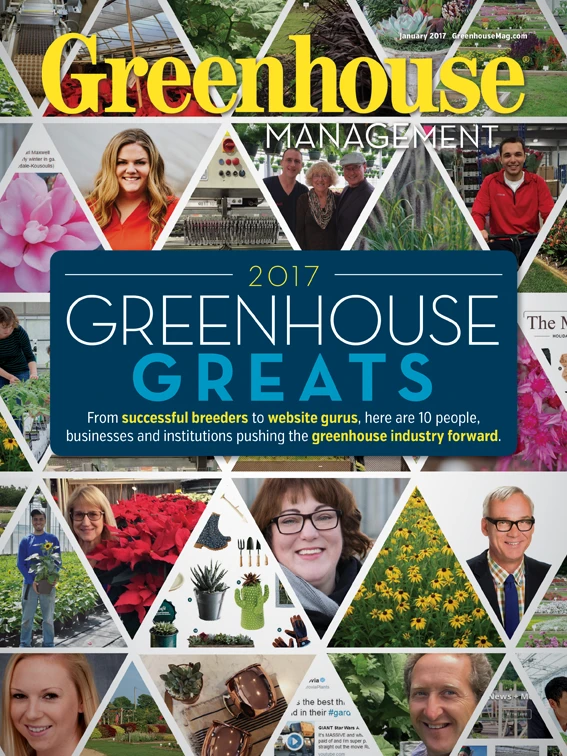
WHY IT’S GREAT:
The Vineland Research and Innovation Centre has more than 100 years of experience in horticultural research, dating back to 1906 when Canadian-American businessman Moses Rittenhouse donated land and a building for an experimental farm called the Vineland Research Station. In 2007, it was renamed the Vineland Research and Innovation Centre, “an independent, not-for-profit organization that does innovation for the horticulture spectrum,” says Dr. Jim Brandle, CEO. They are currently working on more than 60 research projects that will benefit the horticulture industry in North America. The projects vary in size and scope, but take an average of three to four years to complete.
CHOOSING PROJECTS:
Selecting research projects is a process in and of itself. One of the ways Vineland researchers come across project ideas and proposals is through their regular involvement with the industry. “We have broad connections with the grower community, input suppliers, retail customers,” Brandle says. “Ideas get generated up out of those things.” They have formal meetings with industry members and meet as needed when growers or business people come in with particular needs or interests. To decide whether or not to pursue a project, they conduct an “opportunity analysis,” which asks a few simple questions, says Brandle, including: “Is it big enough? Is it something that can really make a difference? And who is better off, and by how much?” Vineland’s goal is to focus on research that will make a broader impact on the industry, not simply solve one grower’s problem.

SHIFTING GEARS:
While greenhouse research wasn’t always a focus, it has become increasingly important over the years, with the first greenhouses being built in the 1980s. In the summer of 2016, a new, high-tech research greenhouse structure at Vineland was officially opened. In addition to increasing the research space, it was intended to better replicate commercial growers’ greenhouse equipment and systems. “You need to be at the same level as [growers] are if you’re going to help them get even better,” Brandle says.
Currently, robotics/automation and biocontrols are two important areas of focus. “Engineering wasn’t an area of research ever on this property,” Brandle says. “Given labor issues, whether that’s labor/supplier, labor/cost or the combination of both that’s affecting the industry on both sides of the border, automation is a big area of focus for us because it’s a big challenge [and opportunity] for our industry.” The biocontrols research includes projects for both greenhouse vegetables and ornamentals and is “front-and-center” for Vineland.

KNOWLEDGE SHARING:
After the research results are finalized, Vineland disseminates the available information to the horticulture industry through a variety of channels. It can happen through provincial extension offices, by licensing it and working with partners to bring it to market, or even starting a company “if we thought that was the only way we were going to get the technology out,” Brindle says.
Vineland may conduct all of their research in-house if they have the capability and equipment to do so, or partner with other university or government scientists who do. They may also have a business partner to get the research and technology out into the industry, and provide financial support.
ACHIEVEMENTS:
While Brandle hopes their greatest greenhouse research achievements are yet to come, so far they include releasing the Pixie grapes mini wine grape varieties; advancing biocontrols in ornamental crops; and developing automation machinery that could help automate the head house. Vineland is currently working on projects that aim to bring “more flavorful tomatoes and new tomato varieties [and] new biocontrol organisms” to market.
You need that new knowledge generation in order to help carry the industry [to be the best in the world]." — Dr. Jim Brandle, CEO
IMPROVING THE FUTURE OF THE GREENHOUSE INDUSTRY:
The future holds a lot of potential for greenhouse growers, but Brandle sees a need for more specific research. “Our industry has reached the point where they need to generate their own knowledge,” he says. “We are, in some places, past the point of adapting other people’s technology. Our summer conditions are much hotter. Our diseases and insect pests are somewhat different. Our markets are different. All of those things need to be considered as you try to elevate yourself from where we are today as a really excellent industry, to the best industry in the world.”
In addition to new knowledge generation, there are “big opportunities now in big data,” Brandle says. Growers are gathering copious data from their operations each day, and aggregating and sharing this data industry-wide could be key in optimizing production.
Lastly, advancing automation technology is crucial to dealing with the lack of qualified labor in a greenhouse operation, Brandle says. The goal for North American greenhouses is developing equipment that can handle the wide variety of crops grown. Brandle believes the industry is up for the challenge, and sees a fully automated greenhouse becoming a reality perhaps in the next 20 years. “The seed goes in one end and a tomato or flower comes out the other end — almost,” he says. “Realistically, if we’re going to stay competitive and stay in business, we’re going to have to do that to some level.”
Get curated news on YOUR industry.
Enter your email to receive our newsletters.
Explore the January 2017 Issue
Check out more from this issue and find your next story to read.
Latest from Greenhouse Management
- Super Charged Moon Juice from Moon Valley Nurseries now available nationally
- 2025 Proven Winners Horticulture Scholarship applications now open
- How to improve inventory and shipping management in the greenhouse
- Leading Women of Horticulture: Anna Ball, Ball Hort, and Terri McEnaney, Bailey Nurseries
- GM CEA HERB Part 2: A guide to increasing the sowing density of culinary herbs
- GM CEA HERB Part 1: Best practices for producing culinary herbs in controlled environments
- USDA fires experts on invasive pests, including Asian citrus psyllid, chilli thrips
- CEA Alliance celebrates bipartisan introduction of Supporting Innovation in Agriculture Act






